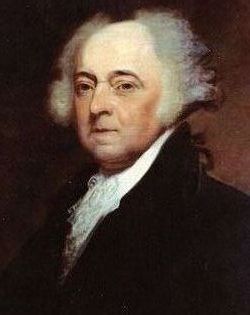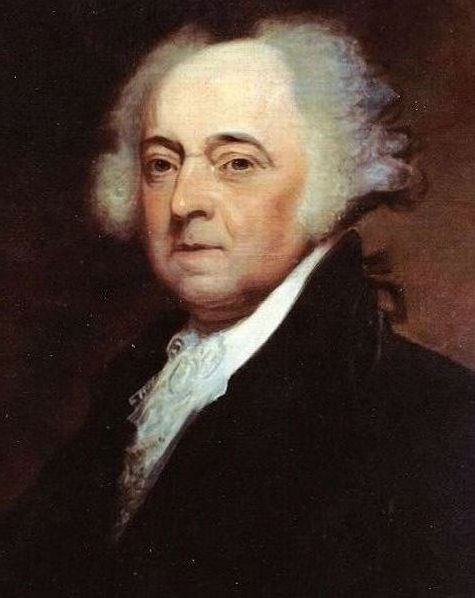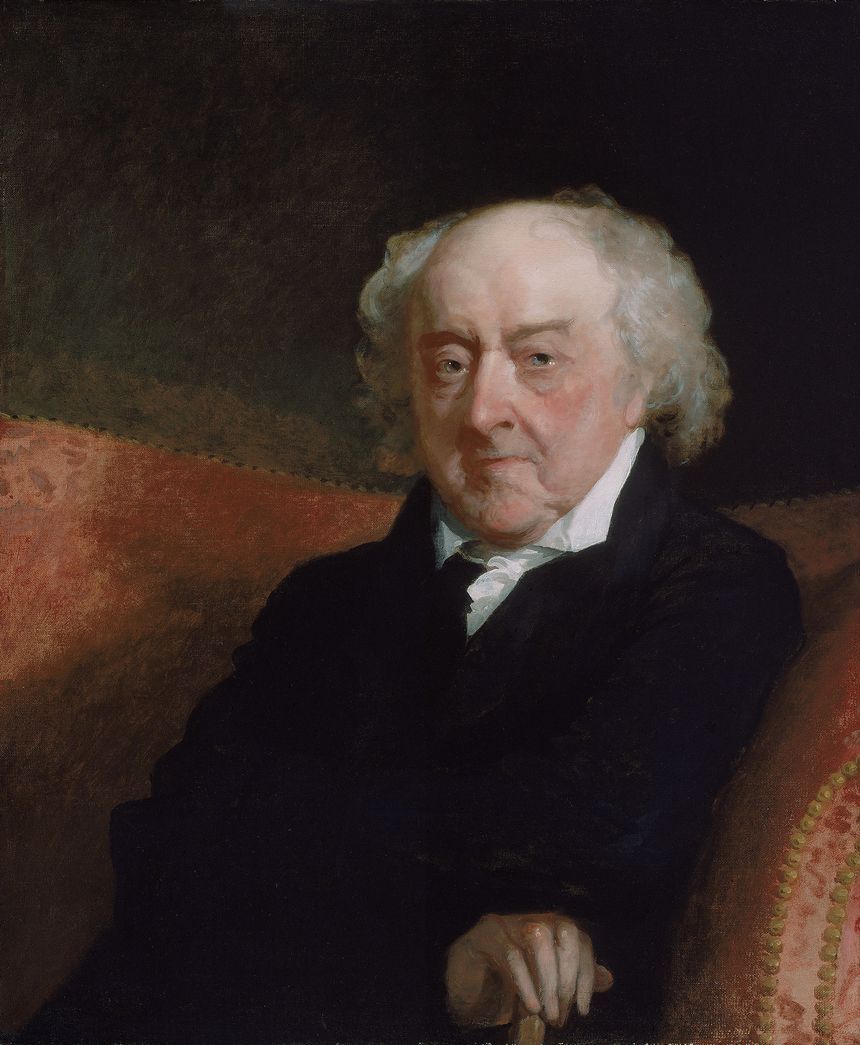Second United States President, First United States Vice President, Signer of the Declaration of Independence from Massachusetts, one of the Founding Fathers of the United States, and Revolutionary War Patriot. Born the first of three sons to John and Susanna Boylston Adams, he was born in Braintree, Massachusetts, (now part of Quincy, Massachusetts), where his father was a Puritan farmer, a Lieutenant in the militia, a town Selectman (town Councilman), and a descendant of the first settlers who had arrived in 1636 to found the town. John attended Harvard College, and after graduating in 1755, taught school in Worcester, Massachusetts, for a few years. He decided he wanted to become a lawyer, and studied law under James Putnam, a prominent lawyer in Worcester. In 1758, he was admitted to the Massachusetts Bar. A careful student, he would write detailed descriptions of events, court cases, and impressions of men, so that he could later study them and reflect upon them. His 1761 notes of the court argument of attorney James Otis on the legality of the Writs of Assistance has served to be one of the best historical records of that argument, helping historians to understand both that law, the public perceptions of the effects of that law, and the patriotism that existed in James Otis. With the Stamp Act of 1765, Adams rose to prominence as an opponent of King George III, in which he argued to the Royal Governor that without representation in Parliament, Massachusetts had not assented to the Stamp Act. In 1770, following the Boston Massacre, the British soldiers involved were charged with murder. When no lawyer in Boston would agree to defend them, Adams, feeling they should have a proper defense, took the case and argued on their behalf. He got six of them acquitted, with the two soldiers who had fired directly into the crowd convicted only of manslaughter and dismissed from the Army. That same month, Adams was elected to the Massachusetts General Legislature, beginning his political career. Adams attended the First and Second Continental Congresses as a representative from Massachusetts. Believing in independence, he nominated George Washington of Virginia for Commander-in-Chief of the Continental Army. Tired of repeating his arguments for independence, Adams wrote a pamphlet "Thoughts on Government" (1776), which articulated his thoughts on independence and, more influentially, on the thought that monarchs, the aristocracy, and the common people all had to be mixed together and represented, in order to bring their support to the government. This thought was considered very radical at the time. "Thoughts on Government" was extremely influential on political thinkers, and was referenced as an authority in virtually every state when each wrote their state constitution. Adams helped write the Declaration of Independence and would sign as a Massachusetts delegate. During the Revolution, he served as head of the Board of War and Ordnance, seeing that the Continental Army received the supplies it needed. In 1779, he wrote most of the Massachusetts Constitution, with help from his cousin, Samuel Adams, and patriot James Bowdoin. During the Revolutionary War, Adams successfully negotiated treaties of recognition and friendship with France, Holland, and Prussia, giving the United States its first foreign recognition as a nation. In 1785, he was appointed as the first Ambassador from the United States to Great Britain. When the Constitution of the United States was adopted, Adams ran for President, coming in second behind General George Washington. In accordance with the United States Constitution, that made Washington President and Adams Vice President. As President of the Senate (the only duties that the Constitution gave the Vice President) he cast 29 tie-breaking votes, a record that still stands today. As the first Vice President, he set the standards for the sessions of the Congress, many of which are still in force today. In 1796, Adams ran for President on the Federalist Party platform against Governor Thomas Pinckney (Federalist Party), Thomas Jefferson (Democratic-Republican Party) and Senator Aaron Burr (also a Democratic-Republican). In a narrow victory, Adams won the Presidency over the next candidate, Thomas Jefferson, thus, under the rules then in place, Jefferson become Adams' Vice President. In the next four years, President Adams built up the Navy and fought an undeclared war with France. He signed into law the Alien and Sedition Acts as a legal instrument against French actions in America (but those acts were later used by some politicians to silence their political opponents) and gave the first ever State of the Union Address. In the election of 1800, each candidate ran for the first time with a Vice-Presidential running mate. In this election, Jefferson teamed with Aaron Burr to defeat John Adams and his running mate, Charles Pinckney. Just before leaving the Presidency, Adams became the first U.S. President to occupy the newly-constructed White House, the official residence of the President. In his final days as President, Adams appointed his Secretary of State, John Marshall, as Chief Justice of the Supreme Court. Marshall would go on to establish much of the legal decisions that influence the Supreme Court today; he is considered one of the best Chief Justices the U.S. ever had. Following his defeat, Adams retired into private life, returning to his farm in Massachusetts. He and Jefferson were bitter because of the infighting of politics and would not speak to each other again until 1812, when Adams finally reconciled with Jefferson. Becoming friends again, the two men corresponded on a number of political and philosophical discussions, giving future historians deep insight into political thought of the times and of the two men. Sixteen months before his death, Adams' son, John Quincy Adams, became the sixth President of the United States, the first son of a President to achieve this office. On July 4, 1826, the 50th Anniversary of the Declaration of Independence, Adams died at his home in Quincy. His last words were "Jefferson lives," considered a tribute of his deep affection for his friend and former rival. However, Thomas Jefferson had died a few hours earlier than his friend, John Adams, that same day.
Second United States President, First United States Vice President, Signer of the Declaration of Independence from Massachusetts, one of the Founding Fathers of the United States, and Revolutionary War Patriot. Born the first of three sons to John and Susanna Boylston Adams, he was born in Braintree, Massachusetts, (now part of Quincy, Massachusetts), where his father was a Puritan farmer, a Lieutenant in the militia, a town Selectman (town Councilman), and a descendant of the first settlers who had arrived in 1636 to found the town. John attended Harvard College, and after graduating in 1755, taught school in Worcester, Massachusetts, for a few years. He decided he wanted to become a lawyer, and studied law under James Putnam, a prominent lawyer in Worcester. In 1758, he was admitted to the Massachusetts Bar. A careful student, he would write detailed descriptions of events, court cases, and impressions of men, so that he could later study them and reflect upon them. His 1761 notes of the court argument of attorney James Otis on the legality of the Writs of Assistance has served to be one of the best historical records of that argument, helping historians to understand both that law, the public perceptions of the effects of that law, and the patriotism that existed in James Otis. With the Stamp Act of 1765, Adams rose to prominence as an opponent of King George III, in which he argued to the Royal Governor that without representation in Parliament, Massachusetts had not assented to the Stamp Act. In 1770, following the Boston Massacre, the British soldiers involved were charged with murder. When no lawyer in Boston would agree to defend them, Adams, feeling they should have a proper defense, took the case and argued on their behalf. He got six of them acquitted, with the two soldiers who had fired directly into the crowd convicted only of manslaughter and dismissed from the Army. That same month, Adams was elected to the Massachusetts General Legislature, beginning his political career. Adams attended the First and Second Continental Congresses as a representative from Massachusetts. Believing in independence, he nominated George Washington of Virginia for Commander-in-Chief of the Continental Army. Tired of repeating his arguments for independence, Adams wrote a pamphlet "Thoughts on Government" (1776), which articulated his thoughts on independence and, more influentially, on the thought that monarchs, the aristocracy, and the common people all had to be mixed together and represented, in order to bring their support to the government. This thought was considered very radical at the time. "Thoughts on Government" was extremely influential on political thinkers, and was referenced as an authority in virtually every state when each wrote their state constitution. Adams helped write the Declaration of Independence and would sign as a Massachusetts delegate. During the Revolution, he served as head of the Board of War and Ordnance, seeing that the Continental Army received the supplies it needed. In 1779, he wrote most of the Massachusetts Constitution, with help from his cousin, Samuel Adams, and patriot James Bowdoin. During the Revolutionary War, Adams successfully negotiated treaties of recognition and friendship with France, Holland, and Prussia, giving the United States its first foreign recognition as a nation. In 1785, he was appointed as the first Ambassador from the United States to Great Britain. When the Constitution of the United States was adopted, Adams ran for President, coming in second behind General George Washington. In accordance with the United States Constitution, that made Washington President and Adams Vice President. As President of the Senate (the only duties that the Constitution gave the Vice President) he cast 29 tie-breaking votes, a record that still stands today. As the first Vice President, he set the standards for the sessions of the Congress, many of which are still in force today. In 1796, Adams ran for President on the Federalist Party platform against Governor Thomas Pinckney (Federalist Party), Thomas Jefferson (Democratic-Republican Party) and Senator Aaron Burr (also a Democratic-Republican). In a narrow victory, Adams won the Presidency over the next candidate, Thomas Jefferson, thus, under the rules then in place, Jefferson become Adams' Vice President. In the next four years, President Adams built up the Navy and fought an undeclared war with France. He signed into law the Alien and Sedition Acts as a legal instrument against French actions in America (but those acts were later used by some politicians to silence their political opponents) and gave the first ever State of the Union Address. In the election of 1800, each candidate ran for the first time with a Vice-Presidential running mate. In this election, Jefferson teamed with Aaron Burr to defeat John Adams and his running mate, Charles Pinckney. Just before leaving the Presidency, Adams became the first U.S. President to occupy the newly-constructed White House, the official residence of the President. In his final days as President, Adams appointed his Secretary of State, John Marshall, as Chief Justice of the Supreme Court. Marshall would go on to establish much of the legal decisions that influence the Supreme Court today; he is considered one of the best Chief Justices the U.S. ever had. Following his defeat, Adams retired into private life, returning to his farm in Massachusetts. He and Jefferson were bitter because of the infighting of politics and would not speak to each other again until 1812, when Adams finally reconciled with Jefferson. Becoming friends again, the two men corresponded on a number of political and philosophical discussions, giving future historians deep insight into political thought of the times and of the two men. Sixteen months before his death, Adams' son, John Quincy Adams, became the sixth President of the United States, the first son of a President to achieve this office. On July 4, 1826, the 50th Anniversary of the Declaration of Independence, Adams died at his home in Quincy. His last words were "Jefferson lives," considered a tribute of his deep affection for his friend and former rival. However, Thomas Jefferson had died a few hours earlier than his friend, John Adams, that same day.
Bio by: Kit and Morgan Benson
Advertisement



